Scientific Management Theory and Human Relations in Organizations
VerifiedAdded on 2020/05/11
|6
|1807
|166
Essay
AI Summary
This essay provides a comprehensive analysis of the scientific management theory and the human relations movement, examining their contributions to modern management practices. The paper begins by outlining the core principles of scientific management, including the emphasis on efficiency, task optimization, and the role of F.W. Taylor. It then explores the human relations movement, highlighting the importance of employee satisfaction, social factors, and the work of Elton Mayo. The essay discusses how these theories have shaped modern management, emphasizing their impact on productivity, employee relations, and organizational success. The paper also examines the practical applications of these theories in contemporary business settings, including the use of systematic techniques, the importance of communication, and the development of a positive work environment. Ultimately, the essay underscores the enduring relevance of both scientific management and the human relations movement in fostering effective leadership and organizational performance.
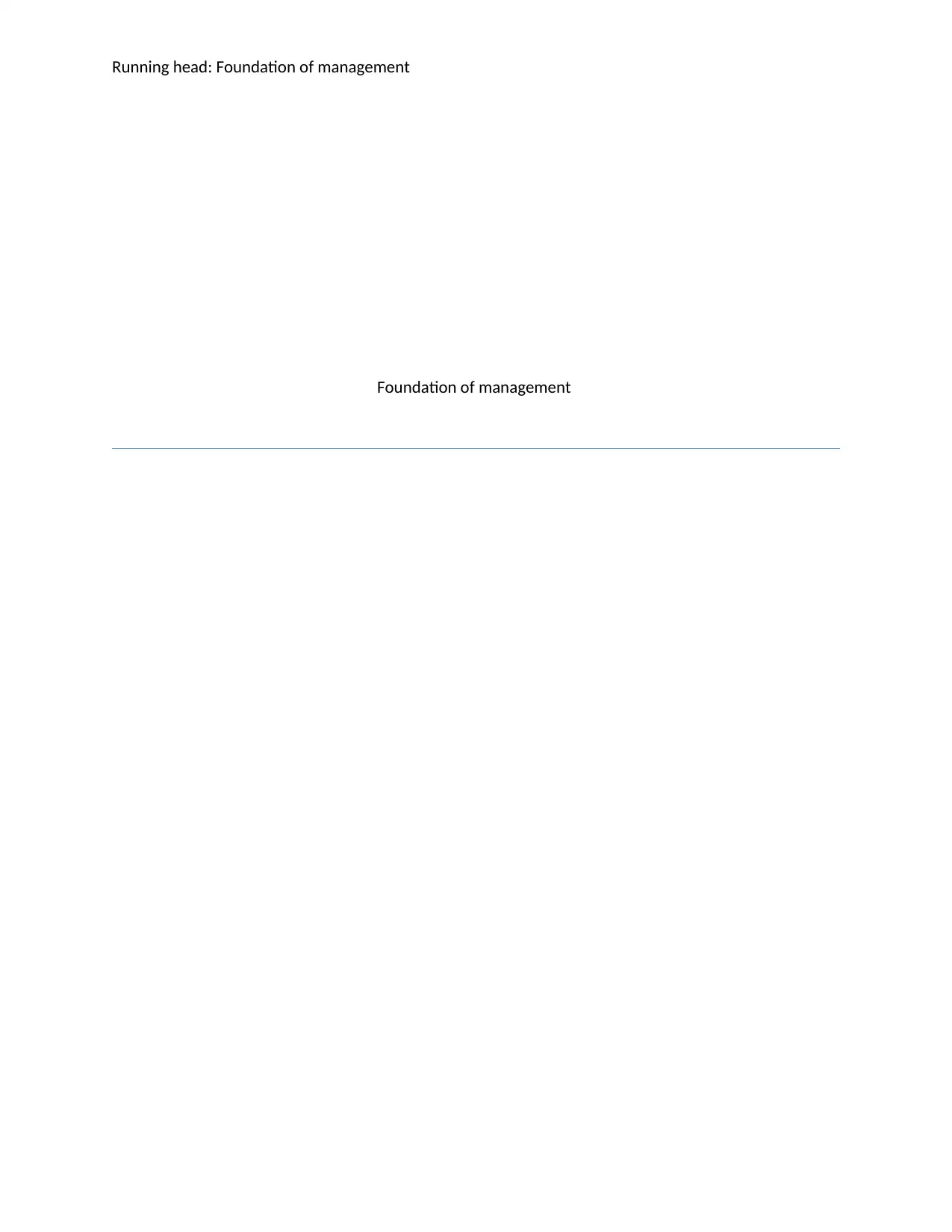
Running head: Foundation of management
Foundation of management
Foundation of management
Paraphrase This Document
Need a fresh take? Get an instant paraphrase of this document with our AI Paraphraser
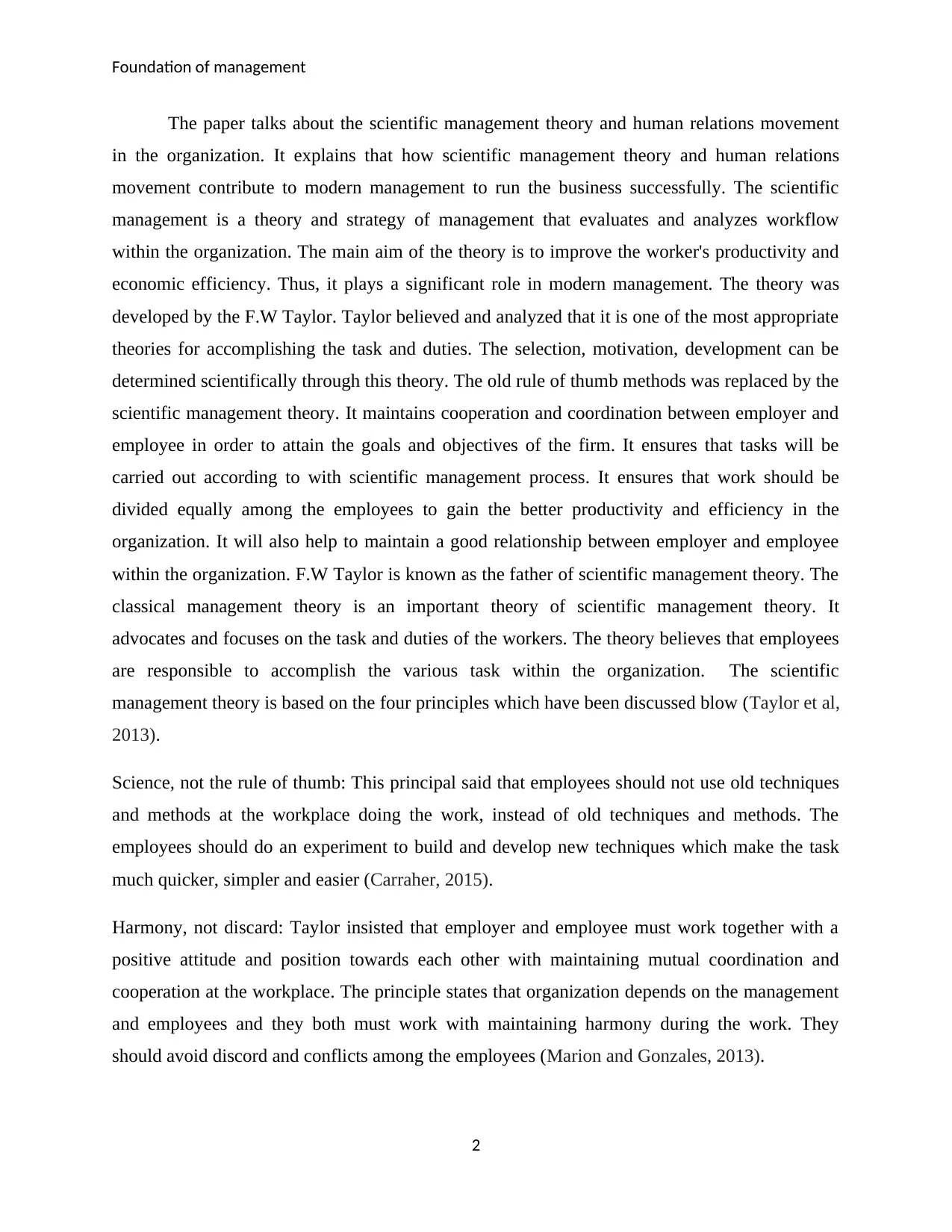
Foundation of management
The paper talks about the scientific management theory and human relations movement
in the organization. It explains that how scientific management theory and human relations
movement contribute to modern management to run the business successfully. The scientific
management is a theory and strategy of management that evaluates and analyzes workflow
within the organization. The main aim of the theory is to improve the worker's productivity and
economic efficiency. Thus, it plays a significant role in modern management. The theory was
developed by the F.W Taylor. Taylor believed and analyzed that it is one of the most appropriate
theories for accomplishing the task and duties. The selection, motivation, development can be
determined scientifically through this theory. The old rule of thumb methods was replaced by the
scientific management theory. It maintains cooperation and coordination between employer and
employee in order to attain the goals and objectives of the firm. It ensures that tasks will be
carried out according to with scientific management process. It ensures that work should be
divided equally among the employees to gain the better productivity and efficiency in the
organization. It will also help to maintain a good relationship between employer and employee
within the organization. F.W Taylor is known as the father of scientific management theory. The
classical management theory is an important theory of scientific management theory. It
advocates and focuses on the task and duties of the workers. The theory believes that employees
are responsible to accomplish the various task within the organization. The scientific
management theory is based on the four principles which have been discussed blow (Taylor et al,
2013).
Science, not the rule of thumb: This principal said that employees should not use old techniques
and methods at the workplace doing the work, instead of old techniques and methods. The
employees should do an experiment to build and develop new techniques which make the task
much quicker, simpler and easier (Carraher, 2015).
Harmony, not discard: Taylor insisted that employer and employee must work together with a
positive attitude and position towards each other with maintaining mutual coordination and
cooperation at the workplace. The principle states that organization depends on the management
and employees and they both must work with maintaining harmony during the work. They
should avoid discord and conflicts among the employees (Marion and Gonzales, 2013).
2
The paper talks about the scientific management theory and human relations movement
in the organization. It explains that how scientific management theory and human relations
movement contribute to modern management to run the business successfully. The scientific
management is a theory and strategy of management that evaluates and analyzes workflow
within the organization. The main aim of the theory is to improve the worker's productivity and
economic efficiency. Thus, it plays a significant role in modern management. The theory was
developed by the F.W Taylor. Taylor believed and analyzed that it is one of the most appropriate
theories for accomplishing the task and duties. The selection, motivation, development can be
determined scientifically through this theory. The old rule of thumb methods was replaced by the
scientific management theory. It maintains cooperation and coordination between employer and
employee in order to attain the goals and objectives of the firm. It ensures that tasks will be
carried out according to with scientific management process. It ensures that work should be
divided equally among the employees to gain the better productivity and efficiency in the
organization. It will also help to maintain a good relationship between employer and employee
within the organization. F.W Taylor is known as the father of scientific management theory. The
classical management theory is an important theory of scientific management theory. It
advocates and focuses on the task and duties of the workers. The theory believes that employees
are responsible to accomplish the various task within the organization. The scientific
management theory is based on the four principles which have been discussed blow (Taylor et al,
2013).
Science, not the rule of thumb: This principal said that employees should not use old techniques
and methods at the workplace doing the work, instead of old techniques and methods. The
employees should do an experiment to build and develop new techniques which make the task
much quicker, simpler and easier (Carraher, 2015).
Harmony, not discard: Taylor insisted that employer and employee must work together with a
positive attitude and position towards each other with maintaining mutual coordination and
cooperation at the workplace. The principle states that organization depends on the management
and employees and they both must work with maintaining harmony during the work. They
should avoid discord and conflicts among the employees (Marion and Gonzales, 2013).
2
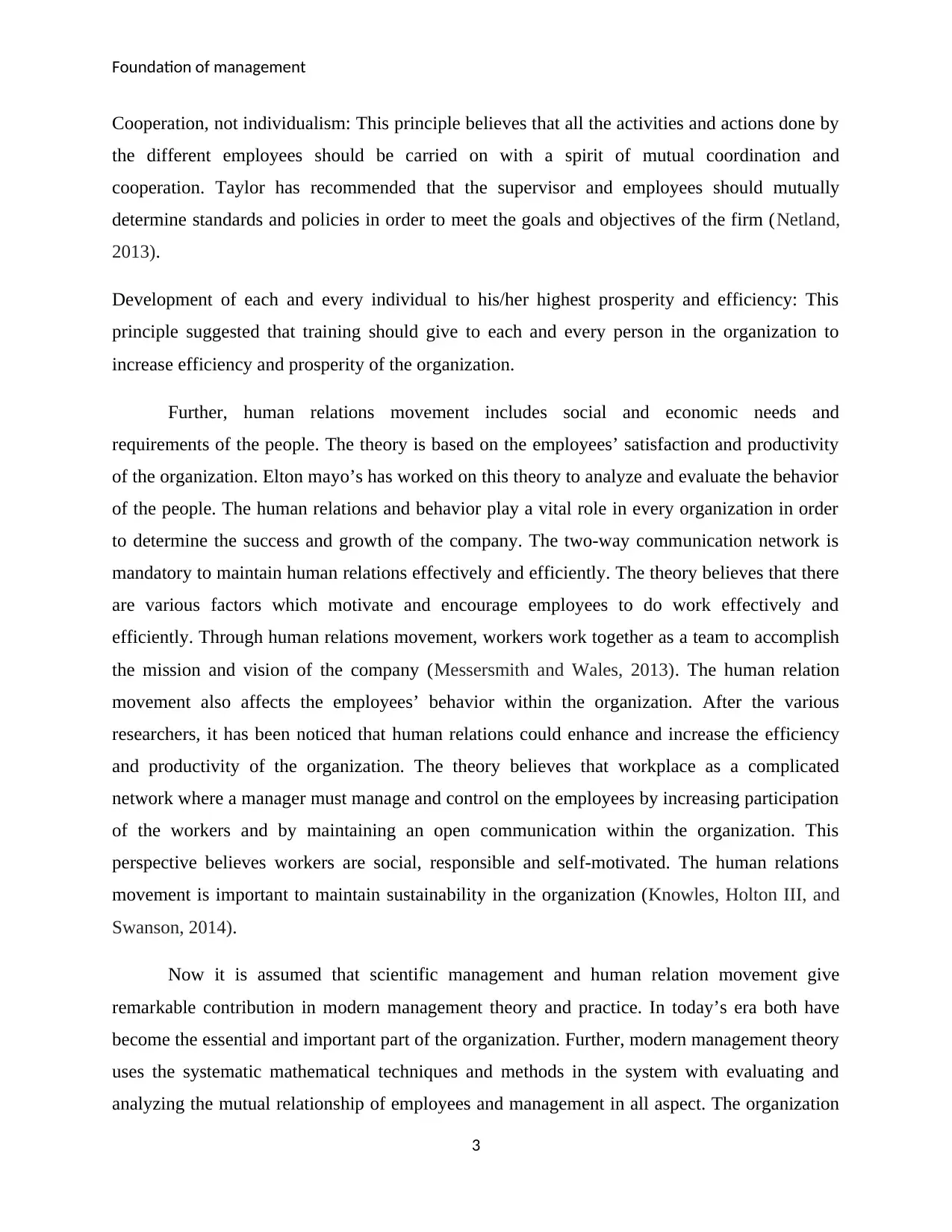
Foundation of management
Cooperation, not individualism: This principle believes that all the activities and actions done by
the different employees should be carried on with a spirit of mutual coordination and
cooperation. Taylor has recommended that the supervisor and employees should mutually
determine standards and policies in order to meet the goals and objectives of the firm (Netland,
2013).
Development of each and every individual to his/her highest prosperity and efficiency: This
principle suggested that training should give to each and every person in the organization to
increase efficiency and prosperity of the organization.
Further, human relations movement includes social and economic needs and
requirements of the people. The theory is based on the employees’ satisfaction and productivity
of the organization. Elton mayo’s has worked on this theory to analyze and evaluate the behavior
of the people. The human relations and behavior play a vital role in every organization in order
to determine the success and growth of the company. The two-way communication network is
mandatory to maintain human relations effectively and efficiently. The theory believes that there
are various factors which motivate and encourage employees to do work effectively and
efficiently. Through human relations movement, workers work together as a team to accomplish
the mission and vision of the company (Messersmith and Wales, 2013). The human relation
movement also affects the employees’ behavior within the organization. After the various
researchers, it has been noticed that human relations could enhance and increase the efficiency
and productivity of the organization. The theory believes that workplace as a complicated
network where a manager must manage and control on the employees by increasing participation
of the workers and by maintaining an open communication within the organization. This
perspective believes workers are social, responsible and self-motivated. The human relations
movement is important to maintain sustainability in the organization (Knowles, Holton III, and
Swanson, 2014).
Now it is assumed that scientific management and human relation movement give
remarkable contribution in modern management theory and practice. In today’s era both have
become the essential and important part of the organization. Further, modern management theory
uses the systematic mathematical techniques and methods in the system with evaluating and
analyzing the mutual relationship of employees and management in all aspect. The organization
3
Cooperation, not individualism: This principle believes that all the activities and actions done by
the different employees should be carried on with a spirit of mutual coordination and
cooperation. Taylor has recommended that the supervisor and employees should mutually
determine standards and policies in order to meet the goals and objectives of the firm (Netland,
2013).
Development of each and every individual to his/her highest prosperity and efficiency: This
principle suggested that training should give to each and every person in the organization to
increase efficiency and prosperity of the organization.
Further, human relations movement includes social and economic needs and
requirements of the people. The theory is based on the employees’ satisfaction and productivity
of the organization. Elton mayo’s has worked on this theory to analyze and evaluate the behavior
of the people. The human relations and behavior play a vital role in every organization in order
to determine the success and growth of the company. The two-way communication network is
mandatory to maintain human relations effectively and efficiently. The theory believes that there
are various factors which motivate and encourage employees to do work effectively and
efficiently. Through human relations movement, workers work together as a team to accomplish
the mission and vision of the company (Messersmith and Wales, 2013). The human relation
movement also affects the employees’ behavior within the organization. After the various
researchers, it has been noticed that human relations could enhance and increase the efficiency
and productivity of the organization. The theory believes that workplace as a complicated
network where a manager must manage and control on the employees by increasing participation
of the workers and by maintaining an open communication within the organization. This
perspective believes workers are social, responsible and self-motivated. The human relations
movement is important to maintain sustainability in the organization (Knowles, Holton III, and
Swanson, 2014).
Now it is assumed that scientific management and human relation movement give
remarkable contribution in modern management theory and practice. In today’s era both have
become the essential and important part of the organization. Further, modern management theory
uses the systematic mathematical techniques and methods in the system with evaluating and
analyzing the mutual relationship of employees and management in all aspect. The organization
3
⊘ This is a preview!⊘
Do you want full access?
Subscribe today to unlock all pages.

Trusted by 1+ million students worldwide
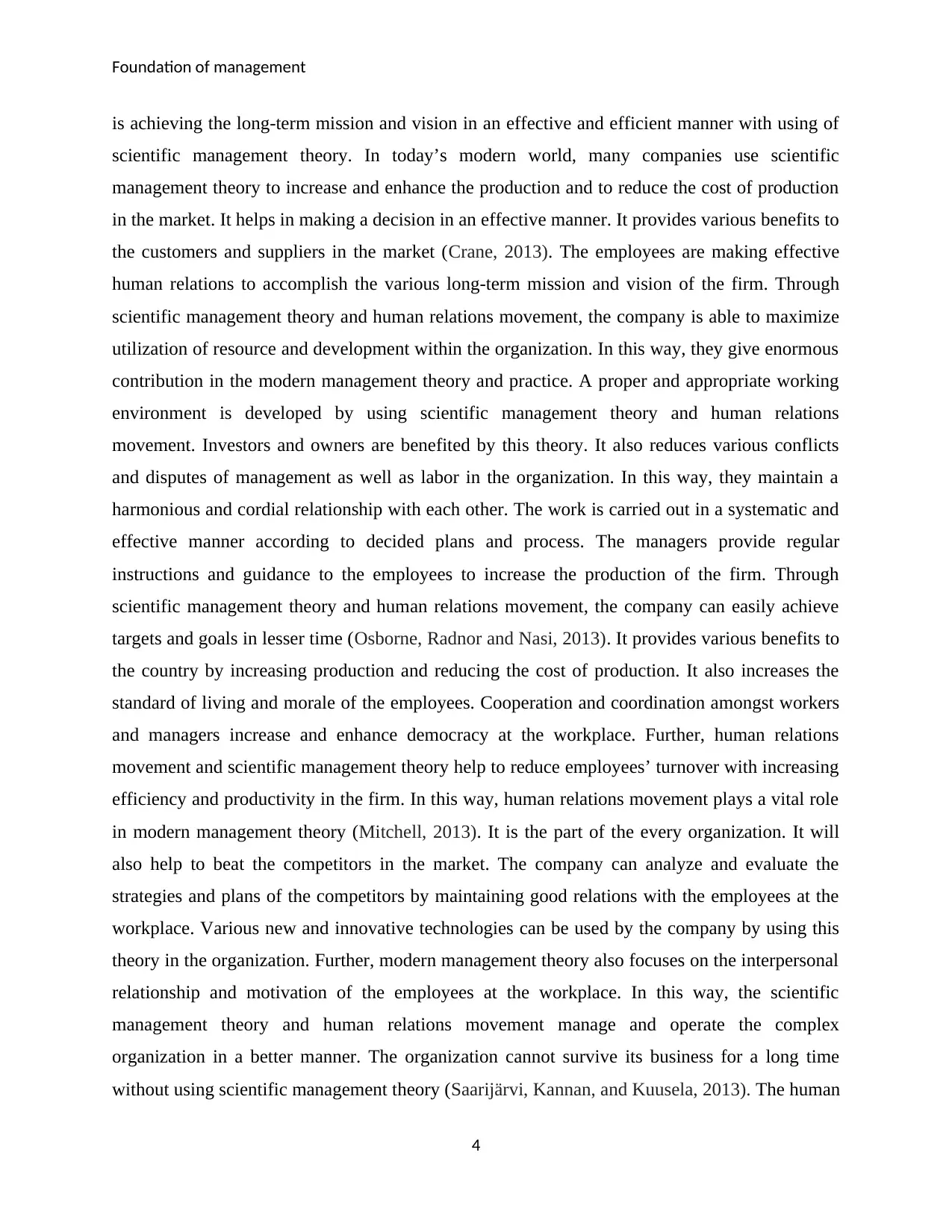
Foundation of management
is achieving the long-term mission and vision in an effective and efficient manner with using of
scientific management theory. In today’s modern world, many companies use scientific
management theory to increase and enhance the production and to reduce the cost of production
in the market. It helps in making a decision in an effective manner. It provides various benefits to
the customers and suppliers in the market (Crane, 2013). The employees are making effective
human relations to accomplish the various long-term mission and vision of the firm. Through
scientific management theory and human relations movement, the company is able to maximize
utilization of resource and development within the organization. In this way, they give enormous
contribution in the modern management theory and practice. A proper and appropriate working
environment is developed by using scientific management theory and human relations
movement. Investors and owners are benefited by this theory. It also reduces various conflicts
and disputes of management as well as labor in the organization. In this way, they maintain a
harmonious and cordial relationship with each other. The work is carried out in a systematic and
effective manner according to decided plans and process. The managers provide regular
instructions and guidance to the employees to increase the production of the firm. Through
scientific management theory and human relations movement, the company can easily achieve
targets and goals in lesser time (Osborne, Radnor and Nasi, 2013). It provides various benefits to
the country by increasing production and reducing the cost of production. It also increases the
standard of living and morale of the employees. Cooperation and coordination amongst workers
and managers increase and enhance democracy at the workplace. Further, human relations
movement and scientific management theory help to reduce employees’ turnover with increasing
efficiency and productivity in the firm. In this way, human relations movement plays a vital role
in modern management theory (Mitchell, 2013). It is the part of the every organization. It will
also help to beat the competitors in the market. The company can analyze and evaluate the
strategies and plans of the competitors by maintaining good relations with the employees at the
workplace. Various new and innovative technologies can be used by the company by using this
theory in the organization. Further, modern management theory also focuses on the interpersonal
relationship and motivation of the employees at the workplace. In this way, the scientific
management theory and human relations movement manage and operate the complex
organization in a better manner. The organization cannot survive its business for a long time
without using scientific management theory (Saarijärvi, Kannan, and Kuusela, 2013). The human
4
is achieving the long-term mission and vision in an effective and efficient manner with using of
scientific management theory. In today’s modern world, many companies use scientific
management theory to increase and enhance the production and to reduce the cost of production
in the market. It helps in making a decision in an effective manner. It provides various benefits to
the customers and suppliers in the market (Crane, 2013). The employees are making effective
human relations to accomplish the various long-term mission and vision of the firm. Through
scientific management theory and human relations movement, the company is able to maximize
utilization of resource and development within the organization. In this way, they give enormous
contribution in the modern management theory and practice. A proper and appropriate working
environment is developed by using scientific management theory and human relations
movement. Investors and owners are benefited by this theory. It also reduces various conflicts
and disputes of management as well as labor in the organization. In this way, they maintain a
harmonious and cordial relationship with each other. The work is carried out in a systematic and
effective manner according to decided plans and process. The managers provide regular
instructions and guidance to the employees to increase the production of the firm. Through
scientific management theory and human relations movement, the company can easily achieve
targets and goals in lesser time (Osborne, Radnor and Nasi, 2013). It provides various benefits to
the country by increasing production and reducing the cost of production. It also increases the
standard of living and morale of the employees. Cooperation and coordination amongst workers
and managers increase and enhance democracy at the workplace. Further, human relations
movement and scientific management theory help to reduce employees’ turnover with increasing
efficiency and productivity in the firm. In this way, human relations movement plays a vital role
in modern management theory (Mitchell, 2013). It is the part of the every organization. It will
also help to beat the competitors in the market. The company can analyze and evaluate the
strategies and plans of the competitors by maintaining good relations with the employees at the
workplace. Various new and innovative technologies can be used by the company by using this
theory in the organization. Further, modern management theory also focuses on the interpersonal
relationship and motivation of the employees at the workplace. In this way, the scientific
management theory and human relations movement manage and operate the complex
organization in a better manner. The organization cannot survive its business for a long time
without using scientific management theory (Saarijärvi, Kannan, and Kuusela, 2013). The human
4
Paraphrase This Document
Need a fresh take? Get an instant paraphrase of this document with our AI Paraphraser
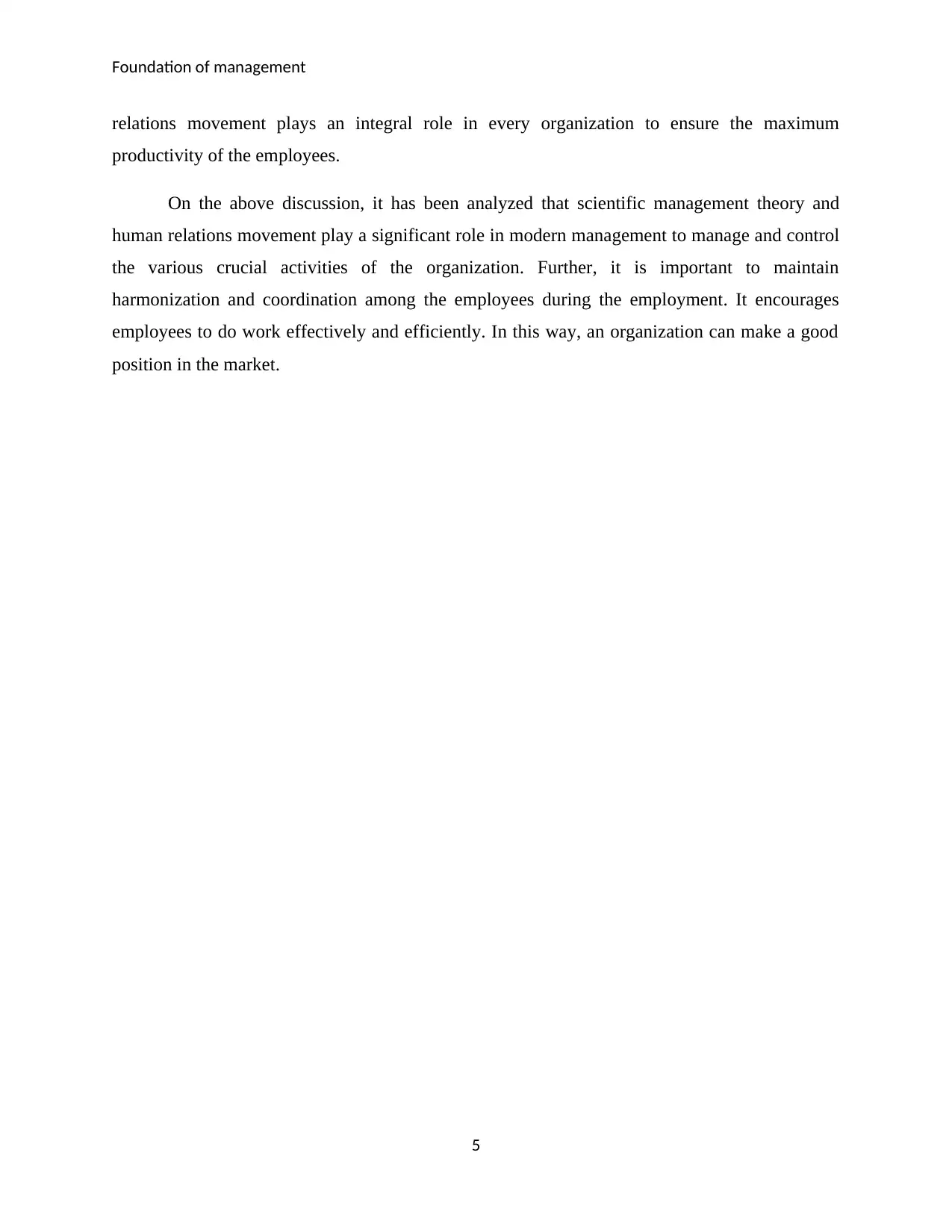
Foundation of management
relations movement plays an integral role in every organization to ensure the maximum
productivity of the employees.
On the above discussion, it has been analyzed that scientific management theory and
human relations movement play a significant role in modern management to manage and control
the various crucial activities of the organization. Further, it is important to maintain
harmonization and coordination among the employees during the employment. It encourages
employees to do work effectively and efficiently. In this way, an organization can make a good
position in the market.
5
relations movement plays an integral role in every organization to ensure the maximum
productivity of the employees.
On the above discussion, it has been analyzed that scientific management theory and
human relations movement play a significant role in modern management to manage and control
the various crucial activities of the organization. Further, it is important to maintain
harmonization and coordination among the employees during the employment. It encourages
employees to do work effectively and efficiently. In this way, an organization can make a good
position in the market.
5
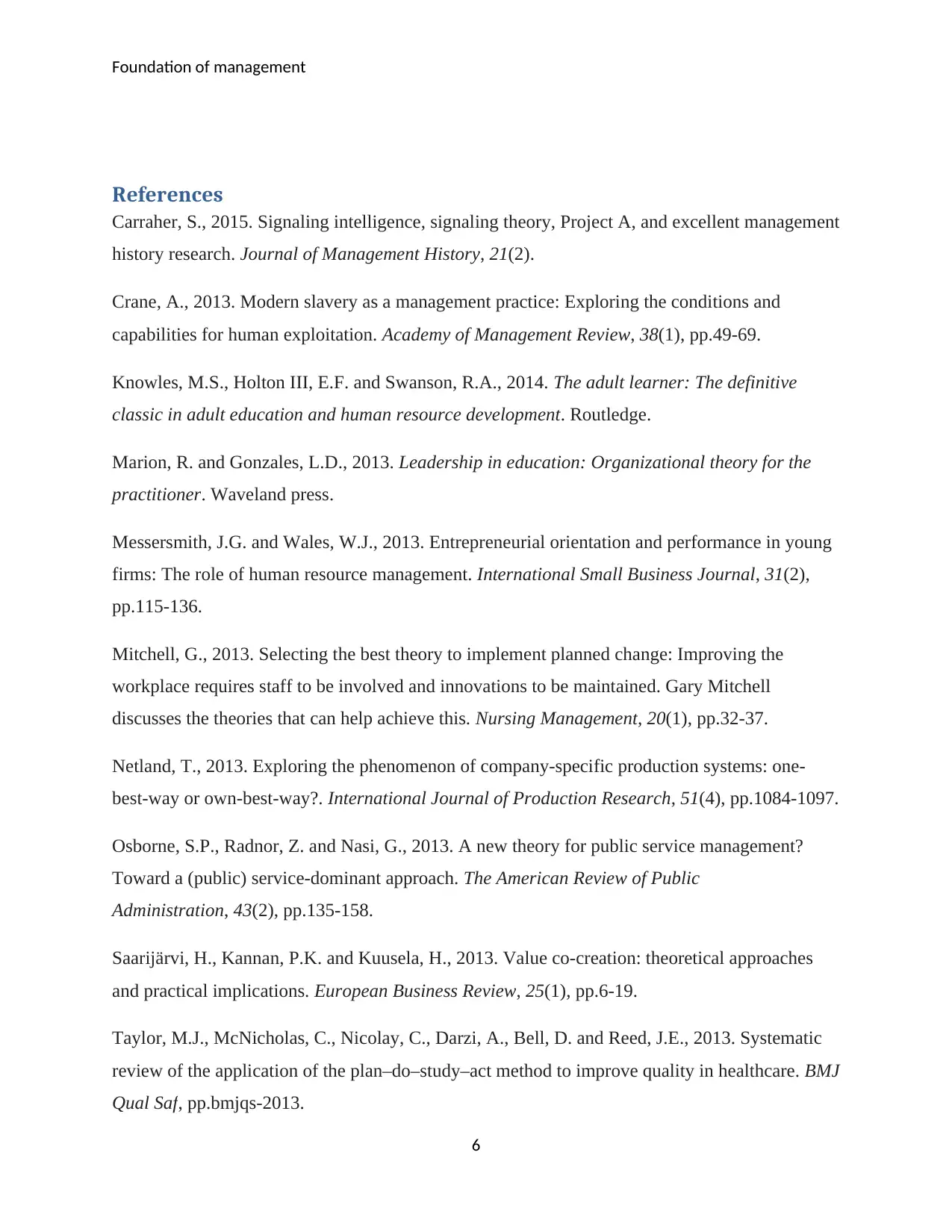
Foundation of management
References
Carraher, S., 2015. Signaling intelligence, signaling theory, Project A, and excellent management
history research. Journal of Management History, 21(2).
Crane, A., 2013. Modern slavery as a management practice: Exploring the conditions and
capabilities for human exploitation. Academy of Management Review, 38(1), pp.49-69.
Knowles, M.S., Holton III, E.F. and Swanson, R.A., 2014. The adult learner: The definitive
classic in adult education and human resource development. Routledge.
Marion, R. and Gonzales, L.D., 2013. Leadership in education: Organizational theory for the
practitioner. Waveland press.
Messersmith, J.G. and Wales, W.J., 2013. Entrepreneurial orientation and performance in young
firms: The role of human resource management. International Small Business Journal, 31(2),
pp.115-136.
Mitchell, G., 2013. Selecting the best theory to implement planned change: Improving the
workplace requires staff to be involved and innovations to be maintained. Gary Mitchell
discusses the theories that can help achieve this. Nursing Management, 20(1), pp.32-37.
Netland, T., 2013. Exploring the phenomenon of company-specific production systems: one-
best-way or own-best-way?. International Journal of Production Research, 51(4), pp.1084-1097.
Osborne, S.P., Radnor, Z. and Nasi, G., 2013. A new theory for public service management?
Toward a (public) service-dominant approach. The American Review of Public
Administration, 43(2), pp.135-158.
Saarijärvi, H., Kannan, P.K. and Kuusela, H., 2013. Value co-creation: theoretical approaches
and practical implications. European Business Review, 25(1), pp.6-19.
Taylor, M.J., McNicholas, C., Nicolay, C., Darzi, A., Bell, D. and Reed, J.E., 2013. Systematic
review of the application of the plan–do–study–act method to improve quality in healthcare. BMJ
Qual Saf, pp.bmjqs-2013.
6
References
Carraher, S., 2015. Signaling intelligence, signaling theory, Project A, and excellent management
history research. Journal of Management History, 21(2).
Crane, A., 2013. Modern slavery as a management practice: Exploring the conditions and
capabilities for human exploitation. Academy of Management Review, 38(1), pp.49-69.
Knowles, M.S., Holton III, E.F. and Swanson, R.A., 2014. The adult learner: The definitive
classic in adult education and human resource development. Routledge.
Marion, R. and Gonzales, L.D., 2013. Leadership in education: Organizational theory for the
practitioner. Waveland press.
Messersmith, J.G. and Wales, W.J., 2013. Entrepreneurial orientation and performance in young
firms: The role of human resource management. International Small Business Journal, 31(2),
pp.115-136.
Mitchell, G., 2013. Selecting the best theory to implement planned change: Improving the
workplace requires staff to be involved and innovations to be maintained. Gary Mitchell
discusses the theories that can help achieve this. Nursing Management, 20(1), pp.32-37.
Netland, T., 2013. Exploring the phenomenon of company-specific production systems: one-
best-way or own-best-way?. International Journal of Production Research, 51(4), pp.1084-1097.
Osborne, S.P., Radnor, Z. and Nasi, G., 2013. A new theory for public service management?
Toward a (public) service-dominant approach. The American Review of Public
Administration, 43(2), pp.135-158.
Saarijärvi, H., Kannan, P.K. and Kuusela, H., 2013. Value co-creation: theoretical approaches
and practical implications. European Business Review, 25(1), pp.6-19.
Taylor, M.J., McNicholas, C., Nicolay, C., Darzi, A., Bell, D. and Reed, J.E., 2013. Systematic
review of the application of the plan–do–study–act method to improve quality in healthcare. BMJ
Qual Saf, pp.bmjqs-2013.
6
⊘ This is a preview!⊘
Do you want full access?
Subscribe today to unlock all pages.

Trusted by 1+ million students worldwide
1 out of 6
Related Documents
Your All-in-One AI-Powered Toolkit for Academic Success.
+13062052269
info@desklib.com
Available 24*7 on WhatsApp / Email
![[object Object]](/_next/static/media/star-bottom.7253800d.svg)
Unlock your academic potential
Copyright © 2020–2025 A2Z Services. All Rights Reserved. Developed and managed by ZUCOL.




